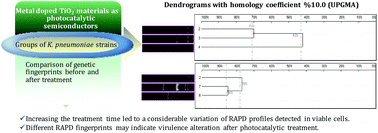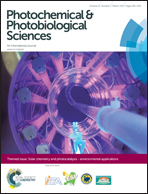Study of the generated genetic polymorphisms during the photocatalytic elimination of Klebsiella pneumoniae in water
Abstract
Klebsiella pneumoniae is considered to be an emerging pathogen persisting under extreme environmentally stressed conditions. The aim of the present study is the investigation of inactivation rates of this pathogen in water by means of heterogeneous photocatalytic treatment under solar irradiation and the induced genetic variance applying RAPD-PCR as a molecular typing tool. Novel Mn- and Co-doped TiO2 catalysts were assessed in terms of their disinfection efficiency. The reference strain of K. pneumoniae proved to be readily inactivated, since disinfection occurred rapidly (i.e. after only 10 min of treatment) and low levels of bacterial regrowth were recorded in the dark and under natural sunlight. Binary doped titania exhibited the best photocatalytic activity, verifying the synergistic effect induced by composite dopants. Applying RAPD analysis to viable cells after treatment we concluded that increasing the treatment time led to considerable alteration of RAPD profiles and the homology coefficient ranged almost between 35 and 60%. RAPD-PCR proved to be a useful typing molecular tool that under standardized conditions exhibits highly reproducible results. Genetic variation among isolates increased in relation to the period of treatment and prolonged irradiation in each case affected the overall alteration in band patterns. RAPD patterns were highly diverse between treated and untreated isolates when disinfection was performed with the Co-doped titania. The broad spectrum of genetic variance and generated polymorphisms has the potential to increase the already significant virulence of the species.

- This article is part of the themed collection: Solar Chemistry and Photocatalysis - environmental applications

 Please wait while we load your content...
Please wait while we load your content...